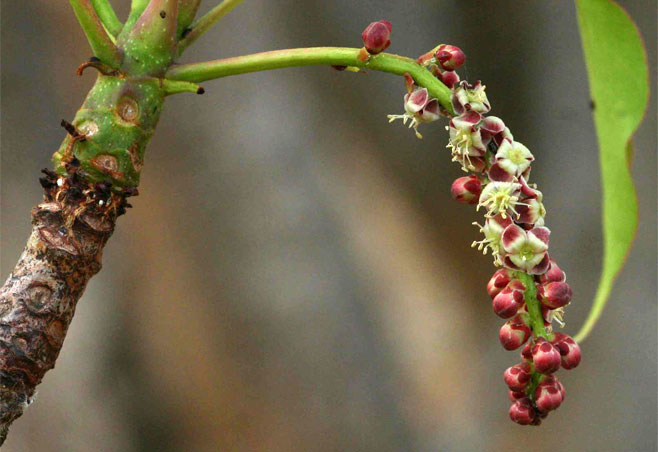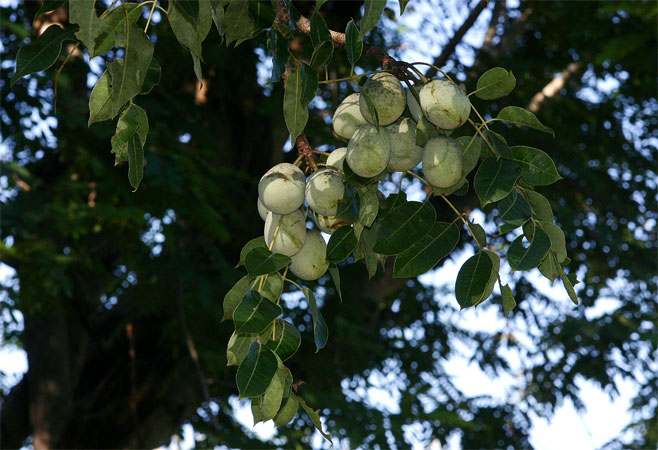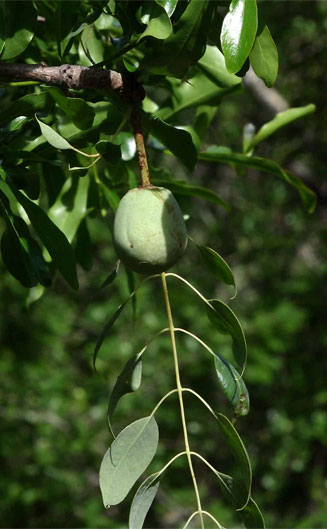|
Sclerocarya birrea
(Marula) Marula [Pedi, Shona]; Maroela [Afrikaans];
Morula [Tswana]; Umganu [Tonga, Zulu]
Life
> eukaryotes >
Archaeoplastida >
Chloroplastida
>
Charophyta > Streptophytina > Plantae (land plants)
> Tracheophyta (vascular plants) > Euphyllophyta > Lignophyta (woody plants)
> Spermatophyta (seed plants) > Angiospermae (flowering
plants)
> Eudicotyledons > Core Eudicots > Rosids > Eurosid II > Order: Sapindales > Family: Anacardiaceae
> Genus: Sclerocarya
 |
|
Sclerocarya birrea, Osborne Dam RP,
Zimbabwe. [photo Bart Wursten ©, Flora of Zimbabwe] |
 |
|
Sclerocarya birrea, Chitengo Camp,
Gorongosa National Park, Mozambique. [photo Bart Wursten ©,
Flora of
Mozambique] |
 |
 |
|
Sclerocarya birrea, between Hot Springs
Resort and Odzi River, Zimbabwe. [photo Bart Wursten ©,
Flora of Zimbabwe] |
Sclerocarya birrea, near the lodges, Lake
Kyle Recreational Park, Zimbabwe. [photo Bart Wursten ©,
Flora of Zimbabwe] |
The Marula tree grows to about 15 m high and is native to subtropical regions of Africa. It produces rounded, yellow fruit about 30 mm
in diameter, which are very tasty and have a Vitamin C level that is 2-4 times
that of oranges. Marula trees play an important role in the lives of many people
in Africa. For instance, the Phalaborwa people rely on marulas as a source of
fruit at times of year when other foods are scarce. They use a special
instrument called a modukulu to extract the nuts inside the fruit. The
Marula has huge potential as a commercial fruit and besides being grown
commercially in Southern Africa, it has been experimentally planted in the Negev
Desert of Israel.
Uses
- The pulp of the fruit is delicious eating.
- Juice is extracted from the pulp and used in the
production of fruit juice blend (e.g Liquifruit ®)
- Marula beer, known as mokhope or ubuganu,
is brewed from Marula pulp, made both at home and commercially.
- Fruit pulp is used to flavour the famous Amarula
liqueur.
- The fruit pulp is used for producing syrup, vinegar,
jelly (it has a high pectin content), preserves and sweets.
- The pip contains three oblong nuts that are cracked
open in order to eat the kernels inside.
- Oil from the fruit is used to glaze dried fruit but
it goes rancid quite easily.
- The oil is also used by Tsonga people in South Africa
and Mozambique for cooking and it is also used by women as a moisturiser and
as a baby oil.
- The bark, roots and leaves are used for medical
purposes to treat heartburn, diarrhoea, diabetes, fever and malaria.
Herbivores
Incomplete list - only hawkmoths featured.
Links
|
